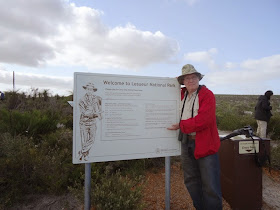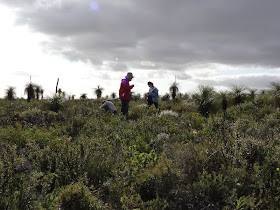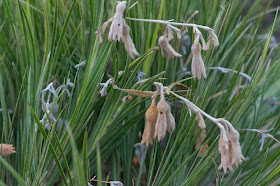By the late afternoon of September 15, 2013, our little group had begun to penetrate the heart of Western Australia's remarkable floral diversity. From our base in Jurien Bay, over 200 kilometres north of Perth, we were to spend the next three days exploring an area so rich in wildflowers that it almost overwhelms the senses. This is the Kwongan, and the wildflowers that grow here are so numerous, and so varied, that visitors have often compared it, in the number and brilliance of its species, to a coral reef on land. Our first stop was one of the richest in the Kwongan: Lesueur National Park, named for the flat-topped mesa known as Mount Lesueur (named, in its turn, for the artist-naturalist Charles Alexandre Lesueur, who sailed past here on the ship Naturaliste at the beginning of the nineteenth century).
Lesueur, gazetted only in 1992, boasts over 900 species of plants - a remarkable total, and even more remarkable when you consider just what sort of place this is. Far from being the nurturing garden that you might expect, the Kwongan - its name taken from a local aboriginal language - is a harsh, dry, punishing landscape where plants must struggle to grow and survive.
Like the similar, and even more diverse, fynbos region of the South African Cape, the Kwongan is an arid coastal sandplain heathland, with nutrient-poor soils and a Mediterranean climate featuring long, dry, hot summers and rain that falls mainly in winter. The vegetation here is scrubby, low and dense.
Its plants, to survive, must have tough, dry leaves - the botanical term is sclerophyllous - and deep, penetrating roots. The number of plant families that dominate the area is comparatively few, but those that have made it here have evolved into species after species, each adapted to slight differences in microclimate, access to water, and availability of nutrients in the soil.
With limited time, the best way to get a taste of Lesueur and its riches is to take the Lesueur Scenic Drive, a one-way, 18.5 km track that loops through some of its best areas.
With only a few hours of daylight to spare we set off around it, pausing as often as we could to pore over the flowers at our feet. Even in that short time, I photographed so many that it will take me four posts to get through them all. This is the first.
Many of the plants here are found nowhere else, or at least nowhere else but in the immediate area. This is one of them: Lesueur Southern Cross (Xanthosia tomentosa), a member of the carrot family (Apiaceae) and a northern relative of the Southern Cross (X. rotundifolia) that we had encountered in the Stirling Ranges. Like its southerly relative, its flowers (the little yellowish things in the photo) are tiny; it is the large white bracts that give it its showy appearance.
After considerable worrying about the best way to lay out my account of our drive through Lesueur, I finally decided that the easiest, and simplest, was to follow it more or less as we experienced it: a myriad of flowers, in (with a few exceptions) no particular botanical order. We can start, then, with one of the Blue Tinsel Lilies (Calectasia sp.), showy members of the peculiar family Dasypogonaceae; for its cousins, you'll have to wait for the next post.
Smokebushes provided a sort of background to the main show, rather as clusters of baby's breath set off the larger blooms in a flower arrangement. This one, Conospermum boreale, is a Kwongan endemic, with a range running through the sandplain country from Perth north to Geraldton. Conospermum is a member of the protea family (Proteaceae), a dominant and diverse heathland family (we'll see more Proteaceae later on).
Dense, often sprawling shrubs dominate in the Kwongan, as in heathlands everywhere.
"Heath" refers to a vegetation type - basically what you see in the Kwongan, the African fynbos or the heather-clad moors of Britain - but there are members of the true heath family (Ericaceae, including the Southern-Hemisphere Epacridaceae) here as well. This one is (I believe) Red Swamp Cranberry (Astroloma stomarrhena).
Many of the most handsome, like this (presumed) Geraldton Wax (Chamelaucium uncinatum), are members of the myrtle family (Myrtaceae).
Others are members of the pea family (Fabaceae). I have this one down as Granny Bonnets (Isotropis cuneifolia), but I confess I am none too sure.
Trees are not totally absent, at least in patches here and there.
This one is another member of the myrtle family (and in fact of the dominant tree genus in Australia, Eucalyptus): Drummond's Gum (Eucalyptus drummondii).
The Drummond in question was James Drummond (1786/7-1863), a Scot who emigrated to Western Australia in 1828 and spent much of the later part of his life collecting plant specimens for botanists in the UK. Over 100 plants were named for him, and according to Wikipedia some sixty of these names are still valid. Here's another: Lasiopetalum drummondii, a localized member of the mallow family (Malvaceae).
Not exactly shrubs, but not really trees either: grass trees (Xanthorrhoea sp.) dot the Lesueur landscape, making it look (if nothing else) particularly Australian.
These cattail-like spikes belong to Lomandra hastilis, a member of a genus whose fifty-odd, mostly Australian, species have been kicked around between a number of plant families, including both the Xanthorrhoeaceae and the Dasypogonaceae, before settling among the Asparagaceae.
Among the plethora of Kwongan endemics were a few familiar faces: Milkmaids (Burchardia sp....
...and Red Ink Sundew (Drosera erythrorhiza), still not in flower...
...as well as a few plants, including this attractive species, that I still have not been able to identify.
I am ending if this first installment on our drive around Lesueur with a focus on a particular, and particularly Western Australian, family, the bloodworts (Haemodoraceae). it is true that this family has members on all the southern continents, plus a few in North America, but there are reasons for attaching it particularly to this Australian state. For one thing, the red spike poking out of the vegetation in this photo, the Red-and-green, or Mangles', Kangaroo Paw (Anigozanthos manglesii subsp. quadrans), is the state's official flower, and appears on its coat of arms. For another, the kangaroo paws include what are surely the most distinctive and memorable Western Australian flowers, even including the many orchids, proteas and other botanical marvels that grow there.
The Haemodoraceae are monocots, related to plants like the pickerelweeds (Pontederiaceae) and more distantly to grass trees, grasses and palms. Monocots produce no wood, so their members cannot form a true part of the heathland shrub layer. Instead, they stand out on their own, drawing attention to themselves by their often peculiar appearance. The family includes the coneflowers (Conostylis sp), plants we had already encountered several times on our trip through the southwest. This one appears to be Prickly Conostylis (C. aculeata), or possibly Grey Cottonhead (C. candicans), or.... oh, well, it's one of them. Its flowers are only just opening.
This one, still in bud, may be Golden Conostylis (C. aurea).
Here is a rather different-looking coneflower, possibly Trumpets (Conostylis androstemma), a species that by now should have finished flowering.
The cat's paws are miniature versions of the kangaroo paws (on the assumption that kangaroos, or at least the large ones, are bigger than cats, or at least the small ones).
Common Cat's Paw (Anigozanthos humilis) is a widespread and variable flower, one that we had already encountered a number of times but, nonetheless, one that I always found difficult to pass by.
Even more impossible to leave unphotographed were the tall and stately stems of Mangles' Kangaroo Paw, which we were now meeting in the wild for the first time. They call attention to themselves for a reason: kangaroo paws are pollinated by birds. Their long stems raise them above the surrounding vegetation, and their bright red color must make them well-nigh impossible for their pollinators to miss.
Though kangaroo paws are familiar enough these days as exotic additions to flower arrangements, see them in the wild is nonetheless a rather startling experience. They are not only gorgeous, but so different from the plants surrounding them that they look as though they had been dropped from Mars – or, perhaps, are actually not plants at all but glass sculptures by Dale Chihuly, scattered about in a garden of real flowers as Chihuly's creations often are.
Their flowers are certainly strange. Except at their tips, the six petals are fused together for most of their length. The claw-like structures hanging beneath them are the stamens, and their position varies from species to species within the genus Anigozanthos. This is apparently an adaptation to make sure that each species dusts pollen on the heads of visiting birds in a different spot, thereby reducing the risk of cross-pollination.
Anyway, whatever its effect on visiting birds, this is a plant that certainly astonished me, and though it ranges along the good part of the South Western Australian coast I am sure that I will always associate it with the plantscape at Lesueur.








%2BDSC_1822.jpg)
%2BDSC_1789.jpg)




%2BDSC_1785.jpg)

%2BDSC_1791.jpg)
%2BDSC_1826.jpg)
%2BDSC_1774.jpg)
%2BDSC_1818.jpg)








%2BDSC_1778.jpg)
%2BDSC_1808.jpg)
%2BDSC_1819.jpg)

%2BDSC_1931.jpg)






%2BDSC_1879.jpg)
%2BDSC_1881.jpg)
%2BDSC_1770.jpg)
%2BDSC_1782.jpg)
%2BDSC_1874.jpg)
%2BDSC_1915.jpg)
%2BDSC_1917.jpg)
%2BDSC_1908.jpg)
%2BDSC_1900.jpg)
%2BDSC_1852.jpg)
%2BDSC_1906.jpg)
%2BDSC_1909.jpg)
%2BDSC_1828.jpg)
%2BDSC_1920.jpg)
%2BDSC_1829.jpg)
No comments:
Post a Comment